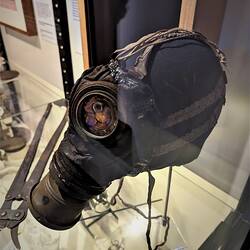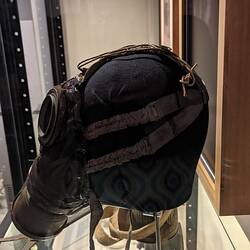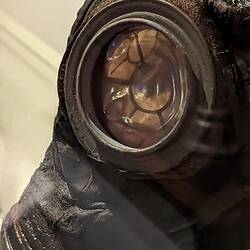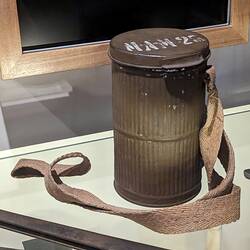Summary
Alternative Name(s): Gas Mask, Gas Respirator
World War I-era gas respirator comprising German 'Lederschutzmaske' (leather protective mask, also known as a Ledermaske), probably M1917 type, with filter attached to front. It was acquired with a French-made ARS (Appareil Respiratoire Special) cannister (container), dated 1918. Cannister includes instructions in French: 'Mode d'emploi / de l' / A.R.S. / Position d'attente: / Passer autour du cou la long laset' - translating to 'Method of use / A.R.S. / Holding (standby) position / Carry with strap around neck.'
The Australian War Memorial holds an example of the Lederschutzmaske (REL/02814.001), which it describes as being made 'from a single piece of chrome-tanned sheepskin dipped in an oil sealant solution'. The record indicates that the edge of the mask is 'coated with a black sealant lacquer partially made from rubber'. The eyepieces are made of celluloid, in two layers, set in steel frames with leather gaskets. The eyepieces have removable internal metal wheels or 'spiders' enabling the inner layer (coated with moisture-absorbing gelatine) to be replaced. Khaki cotton head straps are connected to coiled springs inside cotton sleeves.
The Lederschutzmaske respirator was introduced into German Army service in late 1917 in response to a shortage of raw materials (particularly rubber) in Germany.
The Imperial War Museum explains that the Appareil Respiratoire Special was 'produced by France for Belgian service' and that it was 'issued in quantities from 1917; the design of the ARS respirator was heavily influenced by the German example then in use.' (record EQU 3917)
The use of poison gases added greatly to the horrors of World War I. Several different gases were used by both sides as they refined their arsenal. These included disabling chemicals such as tear gas, the more severe blistering agent, mustard gas, and gases that were rapidly lethal such as phosgene. Front-line soldiers on both sides were systematically issued with gas masks from the second year of the war.
Physical Description
Respirator consisting of round, yellow lenses, set within metal rims, attached to leather face mask. Lenses have frames behind them, There is a black substance painted on the surface of the leather, which is cracked and lifting off. A gas filter is attached below the lenses. Elasticized fabric straps secure the mask around the back of the head in crossed formation.
More Information
-
Collecting Areas
-
Acquisition Information
Purchase
-
Place & Date Used
-
Place & Date Made
-
Inscriptions
On the outer lid of the canister (container): 'M.A.M. 25'. On the base of the canister: '1918' (other text illegible). French text inside the lid of the canister on the paper instruction sheet: 'Mode d'emploi / de l' / A.R.S. / Position d'attente: / Passer autour du cou la long laset. / Mise en place : Saissir les / deux elastiques superieurs avec / une main, de chaque cote du / masque, pencher la tete en / arriere. Introduire profo. [illegible] / ment le menton dans le. [illegible] / gue, puis tirer. [illegible] / elastiques en. [illegible] / arriere, de facon a tendr. [illegible] / ruban du milieu de le tete. / Fixer ensuite l'attache sup- / plementaire derriere le cou. / Bien appliquer les bords du masque avec la main. / Ne jamais demouter / aucune . [illegible]. du / masque.'
-
Classification
-
Category
-
Discipline
-
Type of item
-
Object Measurements
190 mm (Width), 190 mm (Depth), 290 mm (Height)
Width and depth are variable depending on mounting system.
-
Object Measurements
1300 mm (Length), 30 mm (Width)
Measurements of neck strap
-
References
Imperial War Museum Website: [Link 1] accessed March 2014. Also [Link 2] accessed 10 Jan 2023. Australian War Memorial [Link 3] and [Link 4] accessed 10 Jan 2023. Fletcher, Nick, "The development of the gas mask 1915-1918", OnTarget, the journal of the Defence Materiel Organisation, Feb 2006.
-
Keywords
Gas Masks, Respirators, Wars & Conflicts, World War I, 1914-1918, Gas Warfare





